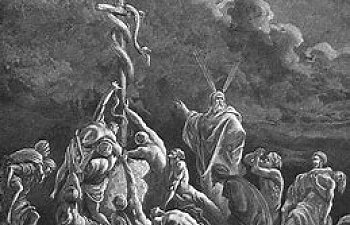Preached September 14, 2019
Fr. Cassian OCSO
Fr. Cassian OCSO
"Make a saraph and mount it on a pole, and if any who have been bitten look at it, they will live."
“And just as Moses lifted up the serpent in the desert, so must the Son of Man be lifted up, so that everyone who believes in him may have eternal life."
Here we are given an example of how scripture reverberates with scripture. Seeking these scriptural reverberations was the preferred method of exegesis in the early church – all the way to our Cistercian Fathers.
Typology. The word comes from the Greek typos, the hollow imprint left by a mold. Such exegesis begins with a present event and seeks its roots in the past, or else reads the Old Testament in the light of the New.
The evangelist John is using this method to connect Jesus’ crucifixion to an historical event on the journey to the Promised Land.
In the desert the people suffered as a result of their complaints against God and Moses. After many died, they came to Moses to say "We have sinned in complaining against the Lord and you. Pray the Lord to take the serpents from us." Moses prays. God proposes a remedy: raise a staff mounted with a serpent. When the people look at the staff, they are healed.
The raised pole in the desert foreshadows the cross on Calvary. “So much for the foreshadowing:” John Chrysostom wrote. “The reality far surpasses it. . . . Jesus has freed us from error and brought us back to the truth. He has made earth heaven, not by changing its physical composition, but simply by showing us how to lead a heavenly life here on earth.”
“God so loved the world that he gave his only Son.” God reconciled us to himself without imputing our sins to us. “We too must enter into this ‘ministry of reconciliation’ that always implies relinquishing one's superiority and opting for the folly of love,” [Benedict XVI] for the joy that lies ahead.
To relinquish our superiority. To give up looking down on others in order to look them in the face. To give up asserting our own ideas in order to hear the good in others’ ideas. To give ourselves to the folly of love, finding the will to love not only our enemies, but all our irritating neighbors.
The cross we have been told to carry is the weight of all that keeps us from being present to God, from opening to Love. It is the weight of our self- regard which keeps us bent over, looking at only our own bodies. To conform ourselves to the cross we must stand upright, looking into the eyes of our neighbor, lifting our head to God. As we extend our arms to fit the cross, we open our arms to welcome another.
As we are pulled between bending to our own self-will and opening to another, we experience our own crucifixion. We are pulled between our willfulness to hold on to ourselves and our willingness to open to God. We will be crucified with Christ. Do not let his gift be counted as pointless, for as we embrace this excruciating tension without weakening, without seeking escape, we are ever more fully conformed to Our Lord.
We, too, will be lifted up, borne up by Christ, who has always been on the way ahead of us to Calvary. He is waiting there to bind us to himself. He has been waiting there to save us, to open us up eternal life. He is still waiting to heal us, to gather us into his joy.

